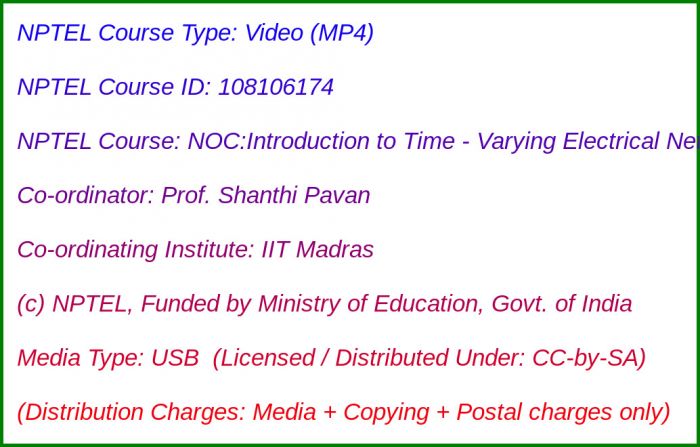NOC:Introduction to Time - Varying Electrical Networks

Media Storage Type : 32 GB USB Stick
NPTEL Subject Matter Expert : Prof. Shanthi Pavan
NPTEL Co-ordinating Institute : IIT Madras
NPTEL Lecture Count : 78
NPTEL Course Size : 9.3 GB
NPTEL PDF Text Transcription : Available and Included
NPTEL Subtitle Transcription : Available and Included (SRT)
Lecture Titles:
Lecture 1 - Course Introduction and Motivation
Lecture 2 - Kirchoff's Current and Voltage Laws, and the Incidence Matrix
Lecture 3 - Power Conservation and Tellegen's Theorem
Lecture 4 - Intuition behind Tellegen's Theorem
Lecture 5 - Tellegen's Theorem and reciprocity in linear resistive networks
Lecture 6 - Why is reciprocity useful in practice?
Lecture 7 - Inter-reciprocity in linear time-invariant networks
Lecture 8 - Inter-reciprocity in linear time-invariant networks (Continued...)
Lecture 9 - Inter-reciprocity in networks with ideal operational amplifiers
Lecture 10 - Review of Modified Nodal Analysis (MNA) of linear networks
Lecture 11 - MNA stamps of controlled sources - the VCCS and VCVS
Lecture 12 - MNA stamps of controlled sources - the CCCS and CCVS
Lecture 13 - Inter-reciprocity in linear networks - using the MNA stamp approach
Lecture 14 - The Adjoint Network
Lecture 15 - MNA stamp of an ideal opamp
Lecture 16 - Properties of circuits with multiple ideal opamps
Lecture 17 - Introduction to noise in electrical networks
Lecture 18 - Noise processed by a linear time-invariant system
Lecture 19 - kT/C noise in a sample-and-hold circuit
Lecture 20 - Noise in RLC networks
Lecture 21 - Total integrated noise in RLC Networks
Lecture 22 - Bode's Noise Theorem - Frequency domain
Lecture 23 - Input referred noise in electrical networks - Part 1
Lecture 24 - Input referred noise in electrical networks - Part 2
Lecture 25 - Input referred noise and the noise factor
Lecture 26 - Noise Factor Examples
Lecture 27 - Motivation to learn about time-varying circuits and systems - Part 1
Lecture 28 - Motivation to learn about time-varying circuits and systems - Part 2
Lecture 29 - Convolution integral for LTV systems
Lecture 30 - Frequency response of an LTV system
Lecture 31 - LTV system example : Time-varying RC filter
Lecture 32 - Linear Periodically Time-Varying Systems (LPTV)
Lecture 33 - Response of an LPTV system to a complex exponential input
Lecture 34 - Harmonic Transfer Functions
Lecture 35 - Zadeh expansion of an LPTV system
Lecture 36 - MNA analysis of LPTV networks
Lecture 37 - MNA stamp of a periodically time varying conductance
Lecture 38 - MNA stamp of a capacitor and a voltage source in an LPTV network
Lecture 39 - Analysis of an example LPTV network - Part 1
Lecture 40 - Analysis of an example LPTV network - Part 2
Lecture 41 - LPTV network analysis, RC filter, time-varying
Lecture 42 - Impedance and admittance in LTI and LPTV networks
Lecture 43 - Thevenin and Norton's Theorems for LPTV networks
Lecture 44 - The N-path principle
Lecture 45 - N-path example
Lecture 46 - Time-domain intuition of the N-path principle
Lecture 47 - N-path example: Time-Interleaved ADCs
Lecture 48 - Dc-dc converter as an LPTV system
Lecture 49 - N-path principle: Multiphase dc-dc converter
Lecture 50 - The N-path filter
Lecture 51 - Computing H_0(j2\pi f_s) for a 4-path filter
Lecture 52 - Input impedance of the 4-path filter at f_s
Lecture 53 - Computing H_0(j2\pi 2 f_s) for a 4-path filter
Lecture 54 - Determining H_0 for input frequency deviations from f_s
Lecture 55 - Reciprocity and Inter-reciprocity in LPTV networks : Part 1
Lecture 56 - Reciprocity and Inter-reciprocity in LPTV networks : Part 2, the transfer-function theorem
Lecture 57 - Why is the transfer-function theorem important?
Lecture 58 - The frequency-reversal theorem for inter-reciprocal (adjoint) LPTV networks : introduction
Lecture 59 - The frequency-reversal theorem for inter-reciprocal (adjoint) LPTV networks : derivation
Lecture 60 - Why is the frequency-reversal theorem important?
Lecture 61 - Inter-reciprocity in signal-flow graphs
Lecture 62 - Applications of inter-reciprocity: analysis of chopped amplifiers
Lecture 63 - Applications of inter-reciprocity: analysis of chopped amplifiers (Continued...)
Lecture 64 - Applications of inter-reciprocity: chopping with square-wave modulation
Lecture 65 - Applications of inter-reciprocity: the switched-RC network
Lecture 66 - Time-domain implications of inter-reciprocity and the adjoint network
Lecture 67 - Time-domain implications of inter-reciprocity and the adjoint network : Example calculation
Lecture 68 - LPTV networks with sampled outputs: Switched capacitor circuits
Lecture 69 - LPTV networks with sampled outputs: A continuous-time delta-sigma data converter
Lecture 70 - LPTV networks with sampled outputs: The equivalent LTI filter
Lecture 71 - Finding the equivalent LTI filter of a sampled LPTV system : example
Lecture 72 - Equivalent LTI filter for a switched-RC network
Lecture 73 - Finding the equivalent LTI filter of a sampled LPTV system : example of a continuous-time delta-sigma modulator
Lecture 74 - Finding the equivalent LTI filter of a sampled LPTV system with offset sampling
Lecture 75 - LPTV networks driven by modulated inputs
Lecture 76 - Introduction to noise in LPTV Networks
Lecture 77 - Noise in LPTV networks with sampled outputs
Lecture 78 - Total integrated noise in networks with R,L,C and periodically operated switches

